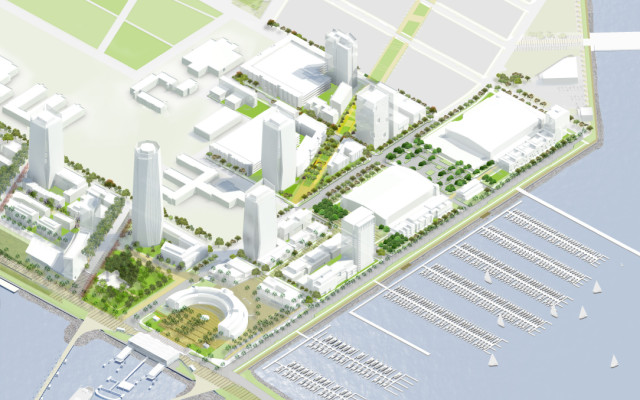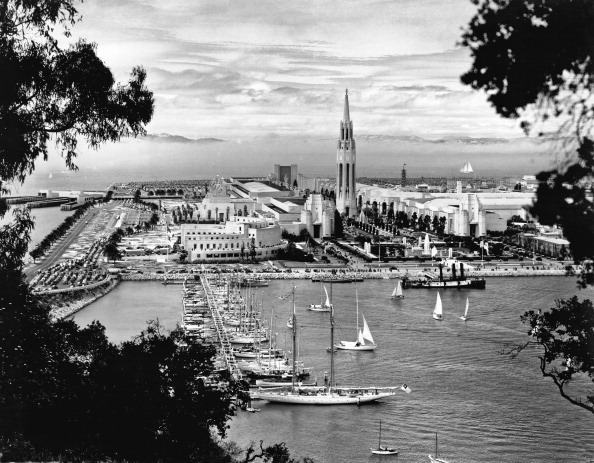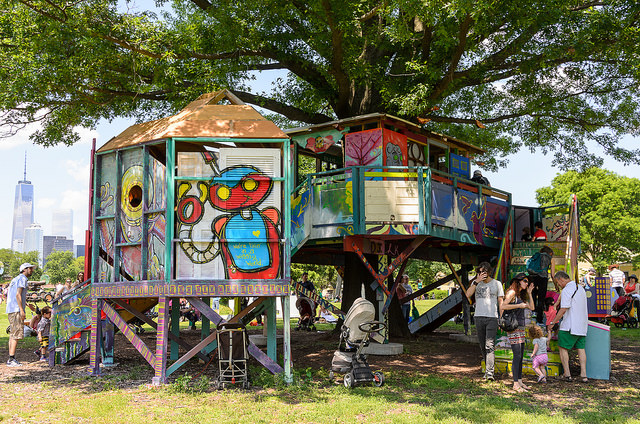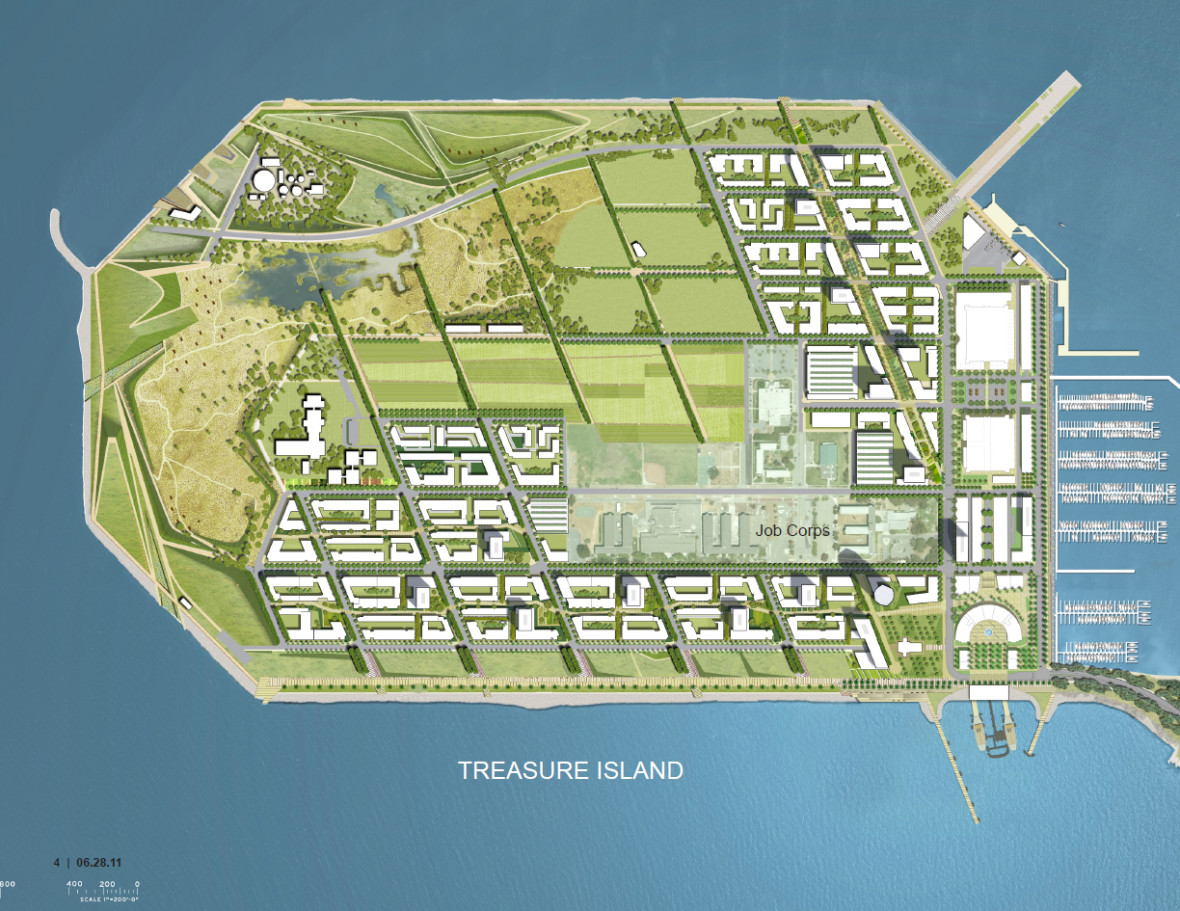In an art-themed version of the movie axiom, “if you build it, they will come,” the San Francisco Arts Commission (SFAC) hopes to draw locals and tourists alike to Treasure Island — and not just for its views.
Over the next 20 years, the man-made tract of land will undergo a massive transformation, on par with its historical shift from world’s fair site to Navy base in 1941. Its population will swell from about 2,000 residents to an estimated 19,000, it will gain a ferry station, up to 500 hotel rooms, and, perhaps most remarkably, $50 million in public art.

As the housing crisis continues in San Francisco and East Bay prices rise to match, the promise of 8,000 new units on Treasure Island (25 percent at below-market rates) could be incentive enough to make people pay attention to a part of the city often left off the maps. But Treasure Island’s future includes more than just housing. And the SFAC’s arts master plan, expected by March 2016, seeks to make the spot an art-world destination.
The cause is led by Jill Manton, director of the SFAC’s Public Art Trust and Special Initiatives, who met with the mayor’s office ten years ago to make sure public art wasn’t neglected in Treasure Island’s long-term development plans. The SFAC will manage pooled funds from the development’s one percent for art fee, the city’s mandate that a building project expend one percent of the construction cost towards public art.
What does this mean for a part of the city currently and conspicuously lacking any public art? Instead of a smattering of monolithic entryway sculptures, the likes of which can be seen in many of San Francisco’s towering new condominiums, Treasure Island will host a deeply considered and generously budgeted public art program, all sited on publicly accessible open space.
Think island-wide treasure hunts, dance performances, light displays, wind-activated art and sculpture gardens. Increasingly for the SFAC, public art is more than just graffiti-resistant plaza sculpture. Treasure Island is an opportunity for expansive definitions of public art to be put to the test on an unprecedented scale for the Bay Area.

Built for the 1939 Golden Gate International Exposition, Treasure Island soon abandoned such frivolity for a Navy station, which remained active until 1997. Today, the site is home to a small, but diverse community, including a Job Corps outpost, the Treasure Island Homeless Development Initiative (providing support and housing for people seeking to exit homelessness) and a single grocery store.
May 29, 2015 marked the first major transfer of 270 acres from the Navy to the city of San Francisco, beginning the long-awaited development process of the “Magic Isle” under the direction of the Treasure Island Development Authority (TIDA).
In addition to homes and hotels, the development plan includes basic infrastructure updates to Treasure Island’s streets, landscaping, an urban agricultural park and a new area of natural habitat called “The Wilds.” Land transfers will continue over the next seven years.
Becky Hogue, a member of TIDA’s Citizen Advisory Board (CAB) and a Treasure Island resident, says she currently knows more about the proposed trees and paving than the public art plan. She hopes the SFAC bucks a trend of excluding residents from the activities going on in their own backyard.
“There are a lot of big events on the great lawn,” Hogue says, pointing to Oracle’s annual OpenWorld “appreciation event” and the Treasure Island Music Festival. “But the residents aren’t part of them.”

In an effort to be more inclusive, Manton is considering ways in which to democratize the curatorial process of a designated open space, a so-called “free zone.” The idea is similar to that of FIGMENT, a weekend-long participatory art event that takes place in a number of cities around the country.
“We are often approached by artists about displaying their work in the city and it often does not work out for various reasons and logistics — aesthetic quality being one of the primary factors,” Manton says. FIGMENT is open to submissions from “anyone who can bring their project by their own means and de-install it when the event is over.”
The Oakland Museum’s Bay Bridge Steel project may provide another possibility for increased public collaboration. The program intends to make salvaged parts of the old bridge available to artists as material for public art projects. Could Treasure Island be one such destination for the transformed spans? Manton says it makes perfect sense: “What could be more site specific?”
Kathrin Moore, a CAB member since the group’s inception in 2001, is enthusiastic about the SFAC’s involvement. Moore thinks Treasure Island’s public art program, if curated correctly, could gain international recognition, likening the large-scale use of open space to documenta, held every five years in Kassel, Germany.
“It’s interesting to talk about these large ideas when the project hasn’t even started,” Moore says. “It’s a way to think about art as a form of civic dialogue ahead of just using art as a way to furnish places.”

As the SFAC develops its plans, it looks to other island-based art projects for inspiration, especially New York City’s Governors Island. Another former military base, Governors Island transferred to the city in 2003 and now hosts a summer-long series of concerts, art events, open studios, family activity days and site-specific projects, including an iteration of FIGMENT.
For Tom DeCaigny, the SFAC’s director of cultural affairs, the Treasure Island development project isn’t just about “placemaking” — a buzzword in the world of urban planning — but, rather, “placekeeping.” That is, honoring Treasure Island’s past and the communities that have shaped it, while recognizing the incredible alterations it will undergo in the years ahead. “As San Francisco is changing, this is really an investment in the role of artists in San Francisco and the artists who have made this city so great,” DeCaigny says.
Working collaboratively with TIDA, the architects and designers behind the development, Treasure Island residents and the San Francisco art community, the SFAC’s arts master plan will pinpoint sites for activation and detail a three-year schedule to jump-start a longer-term process. “Arts plans tend to be dry and rote,” Manton says. “I want this to be a dynamic and inspiring document, full of experimentation.”
While the physical realization of this plan is still years away, the city’s decision to consider public art alongside street parking and building setbacks represents a very different understanding of what it takes to build a thriving urban community. In this context, public art is cultural cachet for residents, tourists and the city itself. And for Treasure Island, it means yet another costume change in its eight decade history — this time, from being in the wings to taking center stage.